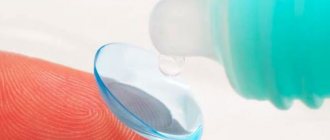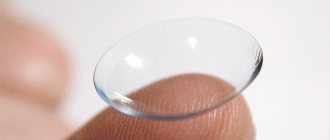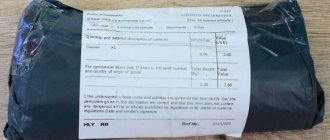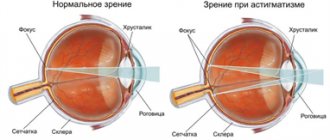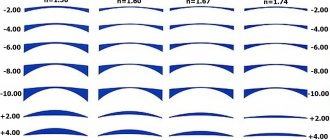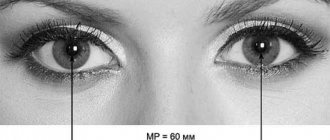Which daily lenses are better - comfortable to wear, easy to care for, easy to clean. Ophthalmologists consider the highest quality optical products to be those that transmit oxygen well and retain moisture. In this case, you don’t have to worry about irritation of the cornea or the feeling of eye fatigue in the evening. Most daily disposable lenses meet these requirements.
Advantages of daily lenses
Buying contact lenses in Moscow is not difficult. One-day optical products top the rating of lenses that ophthalmologists recommend to patients in the first place. Doctors always take care of the safety of the eyes, because the presence of foreign objects in them can worsen the condition of the visual system. During wear, protein and lipid (fat) deposits form on the surface of the lenses. Therefore, after 8-10 hours, the clarity of vision decreases somewhat, and heaviness is felt in the eyes.
To clean contact optics for extended or long-term wear, you have to resort to rinsing and soaking overnight. But no matter how thoroughly a person rinses the lens in the morning, foreign microparticles still remain on it. One-day models are simply thrown away before bed, and a new pair is put on in the morning.
Soft lenses
These ophthalmic products consist of hydrogel or silicone hydrogel. Thanks to the material, they allow oxygen to pass through better than rigid gas permeable lenses. This makes them easier to put on and further use, so they are recommended for new users. Soft optical products are prescribed for the following eye diseases:
- myopia;
- farsightedness;
- astigmatism;
- aphakia (lack of lens in the eyeball);
- presbyopia (age-related farsightedness).
Well, the last thing worth mentioning is the replacement period and wearing mode. According to the replacement period, ophthalmic products are one-day, scheduled replacement (for 2 weeks, 1 month or 3 months) and traditional (for 6, 8 months or a year). In terms of wearing mode, the most common are daytime lenses (worn for a maximum of 10-12 hours). There are other options that can be used longer - from two days or more.
Optimal material
Until 1998, the range of optical stores was represented exclusively by hydrogel daily contact lenses. But due to certain shortcomings of such models, the development of others, made from better materials, did not stop. Silicone hydrogel products soon appeared on sale. Unfortunately, they are also not without their drawbacks.
Hydrogel
The latest generation models have been improved; unlike their predecessors, they allow oxygen to pass through quite well and prevent excess moisture evaporation. The downside is the feeling of heaviness that occurs in the late afternoon. When choosing lenses, you should focus on the hydrophilicity indicator. The closer it is to 78%, the safer the product. 1 dayacuvue moist and dailies aqua comfort plus are especially in demand.
Silicone hydrogel
Unlike hydrogel lenses, such lenses allow oxygen to pass through perfectly. This allows one to avoid compensatory growth of blood vessels into the cornea due to hypoxia. But they also have a drawback - the hydrophobicity of siloxane. It does not retain moisture well, which leads to the lens losing its elasticity after several hours of wear. The outer shell of the eye dries out and becomes irritated due to the excessively tight fit of the thin plate to the cornea. Such disadvantages are uncommon for such models:
- 1-day acuvue try eye;
- dailies total 1;
- myday;
- acuvue oasys hydralux.
While hydrogel models come in different wearing modes, silicone hydrogel models are intended for use only for 24 hours. They should not be cleaned by soaking them in ophthalmic solutions. Contact lenses cheap in our online pharmacy.
Which lenses are better: one-day or two-week?
So, daily lenses, despite their high cost, have many positive characteristics. They do not require a special container to be placed in for storage. By the way, such containers also need care so that they do not become a source of infection over time. Daily lenses are comfortable to wear and provide clear vision. Visual acuity in such lenses always remains unchanged.
In addition to them, two-week lenses are available for sale. If the above type of lenses needs to be thrown away in the evening, then such lenses must be placed in a special container. It should contain an antibacterial solution. After this procedure, the lenses can be reused. Note that two-week lenses are also convenient and comfortable for the eyes. You don’t even have to take them off at night, but then the service life will decrease from fourteen days to seven. They are much cheaper in cost than disposable lenses. And if you wear them regularly, the lens will adapt to the characteristics of your eyes and become more comfortable. Of course, over time, vision clarity may decrease due to lipid and protein deposits. And foreign bacteria can appear in microcracks. Therefore, such lenses are an intermediate link between daily and monthly lenses.
Biocompatible
Biocompatibility - the possibility of contact with any foreign object without harm to health. In ophthalmic practice, the term refers to the ability of the material used for production to interact with the eyeball without causing undesirable consequences. For this purpose, special substances are added at certain technological stages. They are physiological, that is, they are constantly found in tears and mucous membranes. In the ranking of biocompatible lenses for daily wear, bio true one day, pro clear 1 day, and adria one day are firmly in the leading positions.
What happened before
Before the advent of modern contact lenses, people used so-called glass lenses. They were not only expensive, but also had a number of disadvantages . For example, if suddenly the owner managed to scratch them, he had no other choice than to buy new ones. Another major disadvantage was that they interfered with the natural flow of oxygen to the eyes, sometimes leading to eye irritation and even damage.
Aspherical
The fundamental difference between such contact optics and spherical optics is the design. The front surface of the lens has an ellipsoidal shape, so the diameter of the curvature increases from the center to the edges, which increases contrast sensitivity. When wearing aspherical products, any distortion is excluded. Such an “eye-lens” system is considered the most advanced in ophthalmology. By increasing the contrast of vision, the perception of objects becomes clear and sharp. The most popular in this category are soflens daily disposable, pro clear 1 day, bio true one day.
Planned replacement lenses
Planned replacement implies a strictly defined period of use, which must be strictly observed so as not to harm the eyes. Scheduled replacement means using a new pair every two weeks, month, three months - depending on the instructions on the package. After this period, the lenses are thrown away and a new pair is opened. This type has become very common in recent years.
Peculiarities:
- the period of use ranges from two weeks to three months;
- replacement at frequent intervals reduces the risk of accumulation of protein and lipid deposits;
- in case of damage they are always easy to replace;
- comfortable on long trips.
Contact lenses Optima FW from Bausch + Lomb and Adria Season from South Korean ]Interojo[/anchor]. The replacement period is quarterly (90 days).
The use of scheduled replacement lenses requires compliance with certain rules that should not be neglected. Failure to take proper care can lead to inflammation of the cornea.
It is mandatory to store lenses overnight in a solution that should always be clean and fresh. The same applies to the container containing the solution and the tweezers. Lens accessories should also be changed periodically to avoid excessive contamination.
Toric
Such optical products are designed to be worn by patients with astigmatism. This is a congenital or acquired refractive error in which incoming rays are focused not at one, but at several points. The design of the toric lens provides a thickening at the bottom or areas of special stability. Unlike the usual spherical and aspherical models, such a product is not capable of moving. Acuvue moist for astigmatism and daili estoric are often the first choice lenses for patients with astigmatism.
Traditional means of correction
Traditional products are those whose useful life exceeds six months. They were once at the peak of popularity, but today, due to the expansion of the range, they seem less convenient compared to products that need to be replaced frequently. However, many users still prefer them. This is explained primarily by significant savings, since these lenses can be used for a long time. Traditional lenses are sold in bottles.
Traditional Infinity lenses from ]OKVision[/anchor] and Morning Q55 vial from Interojo. The replacement period is six months.
Their main difference from other optical products is that one pair is allowed to be worn for up to 9 months in daytime mode, subject to the operating conditions.
They are made from durable materials to withstand long periods of use. Having bought such a lens, you can forget about purchasing a new one for a long time. When purchasing, do not forget to purchase a special disinfection solution, as well as a storage container, tweezers and a case. Peculiarities:
- The wearing period can be from six months to nine months;
- are made only from hydrogel materials;
- require careful and regular treatment with a disinfectant solution;
- the most favorable price compared to other means of contact correction;
- are available in bottles of one lens.
The rules for caring for traditional lenses are the same as for routine replacement lenses. After each use, the product must be placed in a container with a solution. The mode of wearing traditional contact correction products is always daytime.
Colored
These are optical products for radically changing eye color. They allow a brown-eyed girl to become blue-eyed and vice versa in a few minutes. The harm of such lenses to visual acuity is nothing more than a common misconception. The coloring pigment is located in the area of the iris, which does not have any effect on the perception of objects located near or far. This group can include tint and carnival lenses for daily wear. Fresch look color blens 1 day, beauty lenses 1 day acuvue define radically change your appearance without harm to your health.
Johnson & Johnson Acuvue TrueEye 1-Day contact lenses with Hydraclear – review
Daily lenses are positioned as the most breathable and comfortable to wear, is this really true or have manufacturers simply created another “successfully selling” product?
Characteristics of 1-DAY ACUVUE TrueEye daily lenses:
Material type silicone hydrogel
Oxygen transmission coefficient 118 Dk/t
Moisture content 46%
Refraction range from -12.0D to +6.0D
Radius of curvature 8.5; 9.0
Equipment and price
Packages of 30, 60 and 90 lenses are sold, pay attention to the lenses, not pairs, i.e. standard packaging for 30 pieces, that's 15 pairs of lenses, i.e. 15 days supply! The average price of this pleasure is 1200 rubles. By the way, 1 pair of two-week ACUVUE OASYS lenses costs about 220 rubles!
1-DAY ACUVUE TrueEye daily contact lenses
1-DAY ACUVUE TrueEye daily contact lenses
At the moment, I have used two types of contact lenses from Johnson & Johnson:
- One-day 1-DAY ACUVUE TrueEye
- Two-week ACUVUE OASYS
Which lenses are more comfortable: one-day or two-week lenses?
According to the ophthalmologist, as a rule, all daily lenses have a radius of curvature of 8.5, for me this is less comfortable than the 8.4 radius that my two-week lenses have. Lenses with less curvature are more comfortable for me to wear. Everything else: eye moisture, accumulated fatigue and the accompanying sensations after a long time of wear are basically identical.
Keep in mind that for lenses of two weeks or more (monthly, six months), you need to get tweezers, a storage container and contact lens cleaning liquid.
For one-day ones, you may only need tweezers, because... Such lenses need to be changed every day, and the required amount of solution is in each capsule; if you drop the lens while putting it on, rinse it in the same solution.
1-DAY ACUVUE TrueEye daily contact lenses
Inserting contact lenses into the eyes
You should only put on lenses with clean hands, preferably over a flat, clean surface, in front of a mirror.
I make an adjustment for “dropping”, if the lens falls on a clean surface, then it is enough to simply wash it in the solution, but if it falls on a dirty floor, in food, on a cat or on the ground, then you should discard it and throw it away, there is no need to take risks and bring all dirt and infection into your eyes; in this case, the treatment will cost much more than the price of one lens.
Contact lenses and makeup/tears
Girls, if you don’t have the skill to wear contact lenses, it is better to insert them before eye makeup, otherwise you will carry all the mascara over your eyelids and will be exhausted from washing your contact lenses.
When crying, the contact lens does not interfere with the tear grooves, and you should not worry that it will “wash off” and leak out of the eyes.
1-DAY ACUVUE TrueEye daily contact lenses
Picture clarity
If you choose the right contact lenses, then the clarity of the picture should be ideal, and “correctly” does not always mean exactly in dioptres; an ophthalmologist will help you here.
When wearing contact lenses, you should not feel dizzy or have a headache, and you should not feel a “foreign body” on the surface of your eye.
In the case of 1-DAY ACUVUE TrueEye, my eyes feel completely comfortable throughout the day, even when working at the computer for a long time (approx. 9 hours).
Sleeping in lenses
1-DAY ACUVUE TrueEye are designed for daytime wear, but if you sleep in them for a couple of hours, nothing bad will happen. After waking up, you may experience an unpleasant feeling of stickiness and viscosity in the eye; this can easily be dealt with with eye drops or a single wash with clean water with your eyes slightly open.
Before a long or full night's sleep, you should remove the lenses with clean hands with a gentle pinch and throw them away, because replacement period is daily. Although, I know people who wash one-day products and use them for up to 3 days, but this is at their own peril and risk.
1-DAY ACUVUE TrueEye daily contact lenses
Final opinion
I consider 1-DAY ACUVUE TrueEye quite comfortable, and my personal rating is 4.5 points, simply because I don’t see that exclusive convenience in one-day lenses that is worth overpaying so much for.
Moreover, in my case, two-week lenses with a radius of curvature of 8.4 are slightly more comfortable than daily lenses with a curvature of 8.5, but this is a rather individual parameter, someone may not notice the difference at all!
✔ Dietary supplement for eyes Okuvayt Lutein Forte
✔ Omega-3 from Doppelherz
Source: https://irecommend.ru/content/samye-luchshie-i-bezopasnye-linzy-odnodnevnye-pravda-li-kakie-linzy-vybrat-na-1-den-ili-na-2
Research results
A study of 700 patients who wore disposable contact lenses for 8 months found that patient satisfaction with regard to visual acuity and comfort was higher compared to those who wore extended-wear contact lenses. They also showed no complications with the cornea and no infections.
The information on our website is provided for informational purposes only and should not be used as an experiment without the advice of an ophthalmologist or other medical expert. We do not accept any responsibility for your actions taken without the approval of your ophthalmologist.
The most breathable lenses
When purchasing optics, you need to pay attention to its main indicator: oxygen permeability. Breathable and corrective lenses are comfortable to wear, and some models can be worn constantly without removing them at night.
In the mid-20th century, Czech scientist Otto Wichterle developed the first breathable contact lenses. His goal was to provide maximum convenience and comfort during vision correction for the majority of patients. Indeed, despite the high quality and positive characteristics of optical instruments, they are still a foreign body.
Over the following years, specialists worked in this field and created innovative optical products that are characterized by high gas permeability. The best contact lenses have the designation Dk/t on the packaging. The higher this indicator, the more oxygen such optics allows to reach the eyes.




